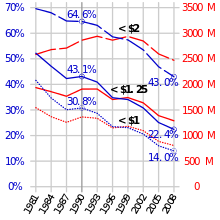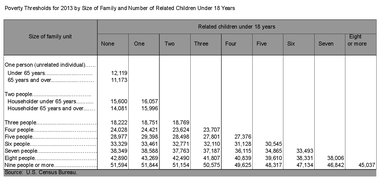
Back خط الفقر Arabic Жизнен минимум Bulgarian দারিদ্র্যসীমা Bengali/Bangla Llindar de pobresa Catalan ھێڵی ھەژاری CKB Práh chudoby Czech Fattigdomsgrænse Danish Armutsgrenze German Sinorê xızaniye DIQ Linio de malriĉeco Esperanto
The examples and perspective in this article deal primarily with the United States and do not represent a worldwide view of the subject. (April 2019) |


The poverty threshold, poverty limit, poverty line, or breadline[1] is the minimum level of income deemed adequate in a particular country.[2] The poverty line is usually calculated by estimating the total cost of one year's worth of necessities for the average adult.[3] The cost of housing, such as the rent for an apartment, usually makes up the largest proportion of this estimate, so economists track the real estate market and other housing cost indicators as a major influence on the poverty line.[4] Individual factors are often used to account for various circumstances, such as whether one is a parent, elderly, a child, married, etc. The poverty threshold may be adjusted annually. In practice, like the definition of poverty, the official or common understanding of the poverty line is significantly higher in developed countries than in developing countries.[5][6]
In September 2022, the World Bank updated the International Poverty Line (IPL), a global absolute minimum, to $2.15 per day[7] (in PPP). In addition, as of 2022, $3.65 per day in PPP for lower-middle income countries, and $6.85 per day in PPP for upper-middle income countries.[8][9] Per the $1.90/day standard, the percentage of the global population living in absolute poverty fell from over 80% in 1800 to 10% by 2015, according to United Nations estimates, which found roughly 734 million people remained in absolute poverty.[10][11]
- ^ webster, The breadline. "The breadline".
- ^ Ravallion, Martin Poverty freak: A Guide to Concepts and Methods. Living Standards Measurement Papers, The World
- ^ Poverty Lines – Martin Ravallion, in The New Palgrave Dictionary of Economics, 2nd Edition, London: Palgrave Macmillan
- ^ Chassagnon, A (2019). "Efficiency and equity" (PDF). Paris School of Economics.
- ^ Hagenaars, Aldi & de Vos, Klaas The Definition and Measurement of Poverty. Journal of Human Resources, 1988
- ^ Hagenaars, Aldi & van Praag, Bernard A Synthesis of Poverty Line Definitions. Review of Income and Wealth, 1985
- ^ "Fact Sheet: An Adjustment to Global Poverty Lines". World Bank. 14 September 2022. Retrieved 26 September 2023.
- ^ "World Bank 2022 poverty lines". Retrieved 10 January 2022.
- ^ "COVID-19 to Add as Many as 150 Million Extreme Poor by 2021". World Bank. 7 October 2020. Retrieved 10 January 2022.
- ^ "PovcalNet". iresearch.worldbank.org. Archived from the original on 27 March 2019. Retrieved 10 March 2019.
- ^ Beauchamp, Zach (14 December 2014). "The world's victory over extreme poverty, in one chart". Vox. Retrieved 17 June 2019.